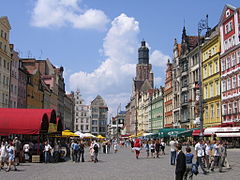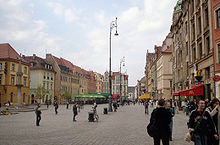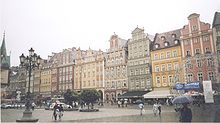- Market Square, Wrocław
-
Market Square 
Market Square, WrocławType Market square Managed by Wrocław City Council Country Poland Region Lower Silesian Voivodeship Address Stare Miasto, Wrocław 51°6′36.40″N 17°1′55.07″E / 51.110111°N 17.0319639°ECoordinates: 51°6′36.40″N 17°1′55.07″E / 51.110111°N 17.0319639°E  Wrocław Market Square in 2005, view from the tower of St. Elisabeth's Church
Wrocław Market Square in 2005, view from the tower of St. Elisabeth's Church
The Market Square, Wrocław (Polish: Rynek we Wrocławiu, German: Großer Ring zu Breslau) is a medieval market square in Wrocław, now the heart of a pedestrian zone. The square is rectangular with the dimensions 205 x 175m.
The buildings around the square are built according to different styles: the middle part (German: Tritt) of the ring is occupied by a block of buildings consisting of the Town Hall, the New City Hall as well as numerous citizens' houses. The market square is an urban ensemble with the two diagonally contiguous areas - the Salt Market and the square in front of St. Elisabeth's Church. Eleven streets lead to the market: two to each corner, two narrow lanes and an opened out side square, Kurzy Targ ("Chicken Market").
The market was founded according to Magdeburg law as early as the rule of Henry I the Bearded between 1214 and 1232. Over time, the patricians' houses appeared and by the middle of the 14th century they had formed a closed construction with the limits of the plots defined.
In the 19th century the square was connected to the tram lines, at first a horse-drawn system, but after 1892 electric. Through to the end of the 1970s, cars were able to drive through along an east-west axis. Between 1996 and 2000 the square was resurfaced, while the east side, the last to be accessible to cars, was pedestrianised.
There are now 60 numbered plots on the market square, with some buildings occupying several. The limits of the plots often follow lines different than those first laid out since estates were often merged and divided in the late Middle Ages. Each property has a traditional name, usually associated with the coat of arms visible on the facade or related to the history of the house itself, for instance Under the Griffins, Under the Blue Sun and Old Town Hall.
Buildings on the square
The inner block stands with an alignment which varies by 7° from that of the outline of the square and surrounding street plan. The reason for this variation has not been established conclusively.
A prominent element of the block is the late-Gothic Town Hall, located on its southern side. The structure is one of the city's most recognisable landmarks, particularly for its distinctive eastern facade.
East side
The east side was historically known as the "Green Pipe Side" (German: Grüne-Rohr-Seite), referring to the verdigris on the copper gutters and downpipes. Its name in Polish is Strona Zielonej Trzciny ("Green Reed Side"). Opposite the main facade of the Town Hall, the east side comprises the houses no. 29 through 41. Notable buildings include the old Barasch Brothers' Department Store, now Feniks Department Store (street no. 29-41).
References
- Olgierd Czerner, Rynek wrocławski, Wrocław: Ossolineum, 1976
- Rudolf Stein, Der Große Ring zu Breslau, Breslau: Priebatsch's Buchhandlung, 1935
- Cezary Buśko, Archeologia lokacyjnego Wrocławia, in Rudolf Procházka: Forum urbes mediiaevi. 1.Sborník příspěvků z konference FUMA konané 10. dubna 2002, Brno: Archaia Brno, 2004, pp. 35-45. ISBN 80-239-2746-2. PDF, Polish with German summary
- Dehio - Handbuch der Kunstdenkmäler in Polen: Schlesien, Herder-Institut Marburg and Krajowy Osrodek Badan i Dokumentacji Zabytkow Warszawa, Deutscher Kunstverlag 2005, ISBN 342203109X
Categories:- Town squares
- Markets in Poland
- Buildings and structures in Wrocław
Wikimedia Foundation. 2010.


